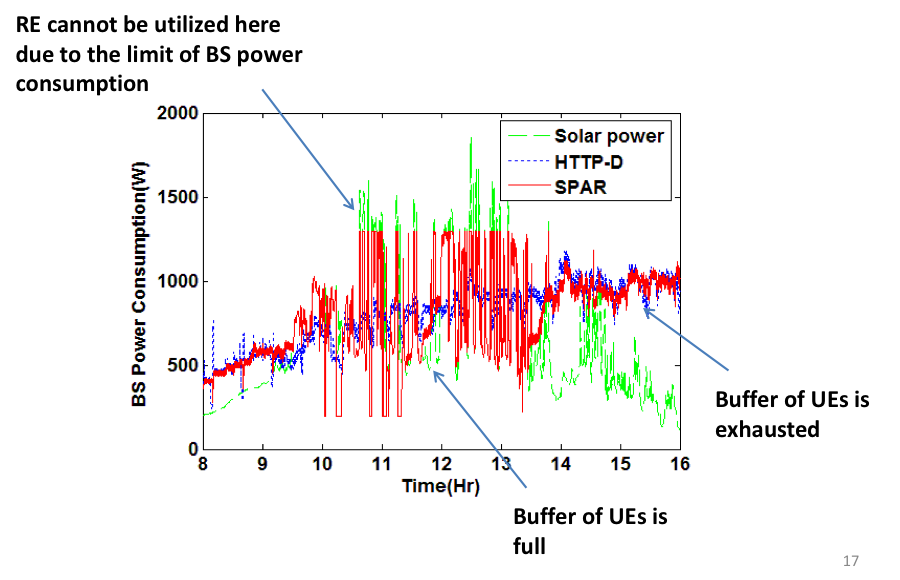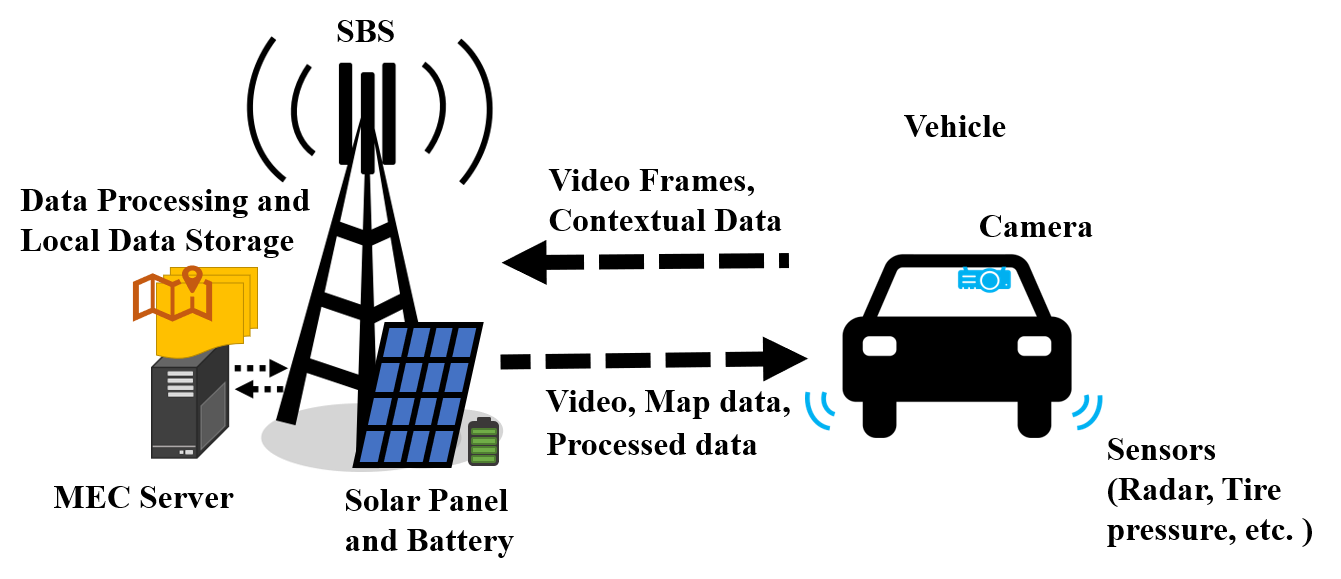Sustainable Wireless Communications with Optimal Utilization of Renewable Energy and Storage
Sustainable Wireless Communications with Optimal Utilization of Renewable Energy and Storage
-
Personnel:
-
PI: Sujit Dey
-
Ph.D. Students: Yu-Jen Ku, Po-Han Chiang
-
Postdoctoral Scholar: Sabur Hassan Baidya
-
-
Description:
The proliferation of mobile data traffic will lead to drastically increasing energy consumption and carbon dioxide equivalent (CO2e) emission in future cellular networks. Since base stations (BSs) consume 80% of the total power in cellular networks, the need to reduce the power consumption of the BSs is crucial for energy-efficient cellular networks. Renewable energy (RE) is a promising solution to reduce grid energy consumption and carbon emissions of BSs. However, the benefit of utilizing RE is limited by its highly intermittent and unreliable nature, resulting in low savings in grid energy. While we refer to grid energy consumption in this report, we note such techniques will also lead to reduction in diesel consumption for off-grid or poor-grid BSs.
To address the mismatch between fluctuating harvested RE at the BS and its power consumption need due to mobile traffic demand, we propose solutions to 1) intra-cell scenario: adapting BS resource allocation, and hence its power consumption, depending on the amount of harvested RE at the BS, and channel condition and buffer level of user equipment (UE) during data download, 2) inter-cell scenario: adapting user association among neighboring BSs according to the geographic distribution of harvested RE and traffic demand by UEs in heterogeneous networks comprising of small cells and macro BSs. Our objective is to maximize utilization of harvested RE at the BSs with minimal use of energy storage (battery), thereby enabling the use of renewable energy feasible at low-cost.Project 1: Renewable Energy-Aware Video Download in Cellular Networks
In project 1, our objective is to minimize grid energy consumption of BSs as well as maximize QoS of users while optimally utilizing harvested RE. The focus of the proposed approach will be to modulate BS energy consumption with the use of both energy storage at the BS and data buffer of the UEs in order to mitigate the mismatch between harvested RE and BS power consumption. The proposed approach transforms the excess RE to excess data delivered to the users and stored in UE data buffer, to draw from in periods when harvested RE is less than BS requirements to reduce grid energy consumption. Though the proposed approach is applicable to any application that utilizes data storage of user devices, we consider the problem for video download/streaming, which will constitute a very large proportion of mobile traffic and hence the BS energy consumption.
Project 2: Quality of Service Optimization for Vehicular Edge Computing with Solar-Powered Road Side Units
The objective of project 2 is to demonstrate the feasibility of small cells powered only by renewable energy, maximizing the longevity of such RE-powered small cells while ensuring the satisfaction of application QoS and minimize service outage of edge-computing based services performed by the MECs associated with such small cells. We decided to focus on a demanding use case for small cells with Vehicular Edge Computing (VEC) for future assisted and autonomous vehicles.
In this emerging use case, solar-powered roadside units (SRSUs), consisting of small cells with Mobile Edge Computing (MEC) server, are used to provide ultra-low latency services for passing vehicles. We aim to develop techniques to minimize the QoS loss in terms of service outage for the offloaded vehicular applications. Our proposed approach is to mitigate the temporal and spatial mismatch of the solar power generation and power consumption of SRSUs through battery charging/discharging management, vehicle association, and SRSU resource allocation strategies. The proposed approach 1) schedules charging/discharging of the batteries of SRSUs based on prediction of the solar generation and the power consumption profile of SRSUs, 2) determine optimal vehicle association and SRSU communication and computing resource allocation for minimal loss of QoS.
Project 3: Sustainable Renewable Energy Powered Testbed
We have built a RE-powered Small Cell (SC) testbed consisting of 1) RE generators and energy storage system, 2) SC and Mobile Edge Computing MEC) server, 3) multiple types of sensors and data collection platforms, and 4) remote-controllable platforms for the above components. The testbed is used to simulate both the power generation and the power consumption of a realistic RE-powered RSU for the study of the sustainability RE-powered RSU.
With the RE-powered Small Cell (SC) testbed, we aim at developing a machine learning model to predict the remaining operation time of a small cell based on the current system and demand status. The feature set includes historical communication traffic, computing demand, solar and wind energy generation profile, environmental factors such as temperature and humidity.-
Publications:
-
Y. Ku, S. Dey, "Sustainable Vehicular Edge Computing Using Local and Solar-Powered Roadside Unit Resources," to appear in 2019 IEEE 90th Vehicular Technology Conference (VTC fall), Honolulu, HI, USA, Sep. 2019. pdf
-
Y. Ku, P. Chiang and S. Dey, "Quality of Service Optimization for Vehicular Edge Computing with Solar-Powered Road Side Units," 2018 27th International Conference on Computer Communication and Networks (ICCCN), Hangzhou, 2018, pp. 1-10 pdf
-
P. Chiang, R. B. Guruprasad and S. Dey, "Optimal Use of Harvested Solar, Hybrid Storage and Base Station Resources for Green Cellular Networks," in IEEE Transactions on Green Communications and Networking, vol. 2, no. 3, pp. 707-720, Sept. 2018 pdf
-
P. H. Chiang, R. Guruprasad and S. Dey, "Renewable energy-aware video download in cellular networks," 2015 IEEE 26th PIMRC, Hong Kong, 2015, pp. 1622-1627 pdf
-
-
Outreach:
-
Posters and Presentations:
Y. Ku, "Enabling Vehicular Edge Computing Services Using Solar-Powered Roadside Units," 2019 UC San Diego Center of Wireless Communications 5G and Beyond Forum (http://5g.ucsd.edu/), May 2019
S. Dey, Keynote presentation, STIP workshop, Ulsan, November 2018
S. Dey, Kyoto Smart City Expo, Kyoto Japan October 2018
Y. Ku, "Quality of Service Optimization for Vehicular Edge Computing with Solar-Powered Road Side Units," 2018 San Diego Regional Proving Ground (RPG) Consortium meeting, June 2018
Y. Ku, "Quality of Service Optimization for Vehicular Edge Computing with Solar-Powered Road Side Units," 2018 UC San Diego Center of Wireless Communications 5G and Beyond Forum (http://5g.ucsd.edu/), May 2018
P. Chiang, "Renewable energy-aware video download in cellular networks," 2017 UC San Diego Center of Wireless Communications 5G and Beyond Forum(http://5g.ucsd.edu/), May 2017
-
-
Broader Impact:
Our research has had the following broader impact outcomes:
We believe that these advances in theory, algorithms and practice will provide new building blocks for green computing and communications infrastructure research.
Furthermore, our ability to develop techniques that enable the use of solar-powered small cells and MECs with minimal QoS loss has helped us decide to incorporate their use for clean computing and communication infrastructure for smart streets that we are designing and prototyping as part of our Smart Transportation Innovation Program (STIP) in partnership with the cities of San Diego and Ulsan http://jacobsschool.ucsd.edu/news/news_releases/release.sfe?id=2507.
-
We have introduced the use of data storage in UEs, besides energy storage at base stations, for effective utilization of solar energy, paving the way for new approaches for green communication networks
-
We have developed a novel online algorithm which simultaneously performs base station power control and battery charging/discharging for minimization of grid power consumption
-
We have developed renewable energy aware service off-loading methods for small cells with MECs for vehicular traffic
-
For the first time, our research demonstrated the feasibility of powering small cells only with harvested solar energy without any shutdowns for realistic communication traffic and computing loads
-
-
Simulation and Software Code:
The following simulation data, simulation framework and software code (developed in Matlab) are provided below:
-
Historical solar irradiance and BS utilization data
-
The proposed Lyapunov-based online algorithm (L-SPAR) for grid power minimization, and simulation results (Project 1)
-
A practical traffic flow model based on historical traffic data
-
Framework to simulate mobility, channel model, and service requests of vehicles with different communication and computing needs
-
QLM algorithm including battery scheduling and user association, and simulation results (Project 2-A)
-
DURQ algorithm including battery scheduling, user association, SRSU resource allocation, and simulation results (Project 2-C)
-
Project 2-B
-
-
|
|
This material is based upon work supported by the National Science Foundation under Grant No. CNS - 1619184 . Any opinions, findings, and conclusions or recommendations expressed in this material are those of the author(s) and do not necessarily reflect the views of the National Science Foundation. |

